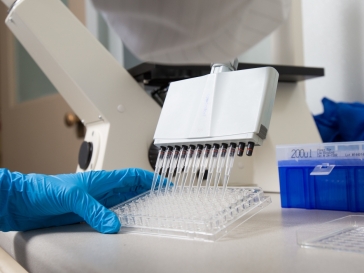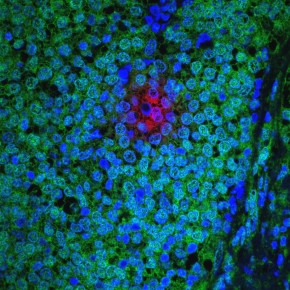Silent Spring’s Safer Chemicals Program
 Yet, the effects of these exposures may not appear until decades later. We shouldn’t have to wait that long to find out if a chemical used today, or a new one coming on the market, causes breast cancer.
Yet, the effects of these exposures may not appear until decades later. We shouldn’t have to wait that long to find out if a chemical used today, or a new one coming on the market, causes breast cancer.
Thanks to Silent Spring’s Safer Chemicals Program, we won’t have to. Current methods used by regulators for predicting the toxicity of chemicals are not focused on identifying breast carcinogens. Our innovative research program aims to fill that gap. We are developing new cost-effective ways of screening chemicals for their effects on the breast. Knowledge generated by this effort will help government agencies regulate chemicals more effectively and assist companies in developing safer products.
The ultimate goal is to shift the burden so that it’s no longer on consumers to reduce their exposures to toxics, but on companies and regulators to ensure the chemicals that make their way into consumer products are safe. Manufacturers won’t be able to say, “I didn’t know that ingredient caused breast cancer.”
 To pursue this goal, we have assembled a top-notch team of scientists led by Silent Spring’s Research Director Ruthann Rudel, a nationally-recognized expert in breast cancer toxicology. She and her team are tackling the problem on several fronts. Examples of projects include:
To pursue this goal, we have assembled a top-notch team of scientists led by Silent Spring’s Research Director Ruthann Rudel, a nationally-recognized expert in breast cancer toxicology. She and her team are tackling the problem on several fronts. Examples of projects include:
- BCScreen: With high throughput screening technology, we are exposing breast cancer cells to different chemicals and looking for disruptions such as DNA damage, increased estrogen receptor activity, or changes in the expression of genes involved in breast development and tumor growth. We are also using the technology to test chemicals on breast organoids (models of human breast tissue) to reveal the effects of chemicals on normal breast cells before they become cancerous.
- The Human Exposome: New sophisticated detection tools can analyze thousands of small molecules in a single blood sample, allowing us to study the entire spectrum of environmental chemicals found in the human body—everything an individual may be exposed to in their environment—otherwise known as the human exposome. We are using this approach in our study of women firefighters, nurses, and office workers to uncover new exposures and to see whether these new exposures are associated with early biological markers of breast cancer.
- Estrogen Uppers: Prolonged exposure to estrogen is a risk factor for breast cancer. We know breast cancer drugs called aromatase inhibitors work by blocking the transformation of hormones called androgens into estrogen. Therefore, we are investigating whether certain environmental chemicals have the opposite effect. Using test data from the U.S. Environmental Protection Agency, we are zeroing in on chemicals that encourage the body to produce more estrogen, thereby increasing breast cancer risk.
The ultimate goal is to shift the burden so that it’s no longer on consumers to reduce their exposures to toxics, but on companies and regulators to ensure the chemicals that make their way into consumer products are safe.
Silent Spring’s Safer Chemicals Program will not only help regulators and manufacturers quickly identify chemicals that increase breast cancer risk to prevent their use in everyday products, our research is also advancing science on how breast cancer develops. By working to develop safer chemicals, we are uncovering the biological pathways by which chemicals cause breast cancer and identifying new potential strategies for early interventions.
Our goal is to support the Safer Chemicals Program with a $5 million fund over the next ten years. But we can’t do it without your help. Please join us in this critical effort to create safer products that don’t cause breast cancer, today and for generations to come.